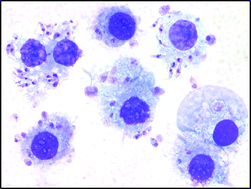Photodynamic therapy (PDT) is emerging as a therapeutic modality in the clinical management of cutaneous leishmaniasis (CL). The efficacy of PDT against CL has been demonstrated previously with aminolevulinic acid, although the prolonged terms of therapy were less than ideal, and the search for new photosensitizers (PS) is ongoing. However, phenothiaziniums have demonstrated high parasiticidal effects in vitro. The subject of our investigation is the in vivo activity of two PS, 5-ethylamino-9-diethylaminobenzo[a]phenoselenazinium chloride (EtNBSe) and (3,7-Bis(N,N-dibutylamino) phenothiazinium bromide (PPA904). The results of our comparative analysis of the efficacy of these two phenothiazinium analogues demonstrated a high antiparasitic activity of EtNBSein vitro, and the higher efficacy of PPA904 in a mouse model of CL. The kinetics of photodestruction are different in parasite and mammalian cells, and with both dyes, the macrophages are more susceptible to photodynamic effects than L. major parasites. As the number of parasites in the lesions undergoes a biphasic change, temporarily increasing on days 2–4 and decreasing on days 5–7, more than one treatment is required within an interval of 5 to 7 days. We have also shown that PPA904-PDT can provide an immunomodulating, dose-dependent efflux on IL-12p70 production. This mechanism could be responsible for promoting a more rapid healing in PPA904-PDT treated mice. Our initial data indicate that phenothiaziniums exhibit a high parasiticidal effect in vivo against CL; this finding may be of use in establishing curative PDT regimens for future clinical trials.

You have access to this article
 Please wait while we load your content...
Something went wrong. Try again?
Please wait while we load your content...
Something went wrong. Try again?


 Please wait while we load your content...
Please wait while we load your content...